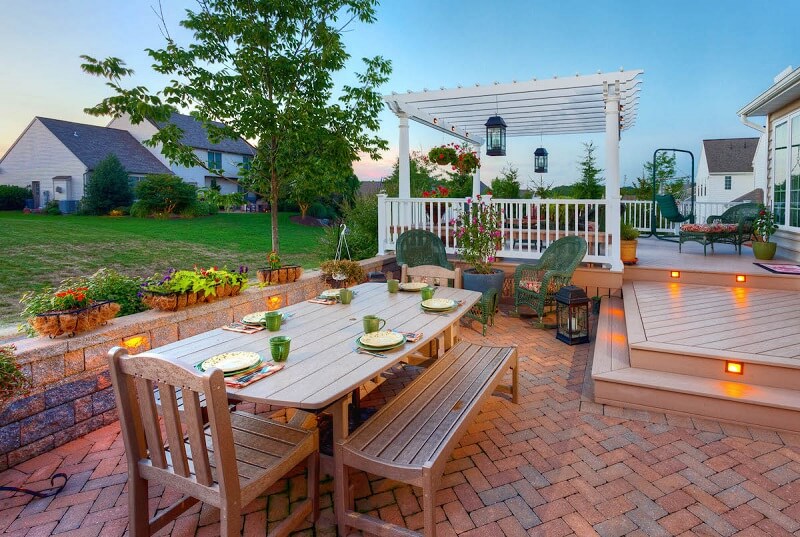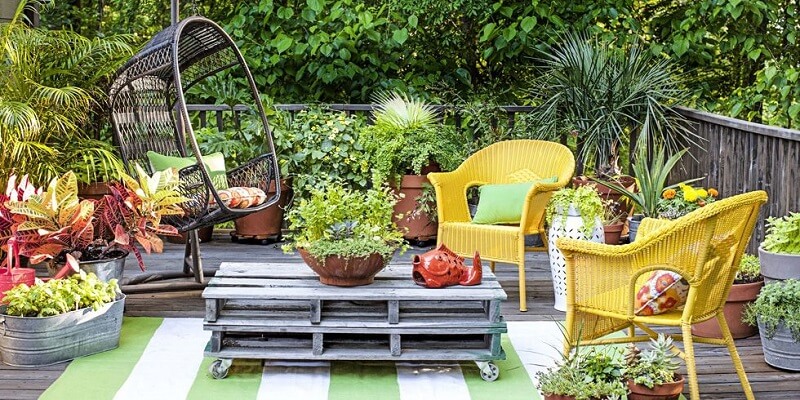Choose your outdoor furniture
Once you’ve planned how to use your outdoor living space and figured out how much space you’ll have to work with, you can finally start equipping it.
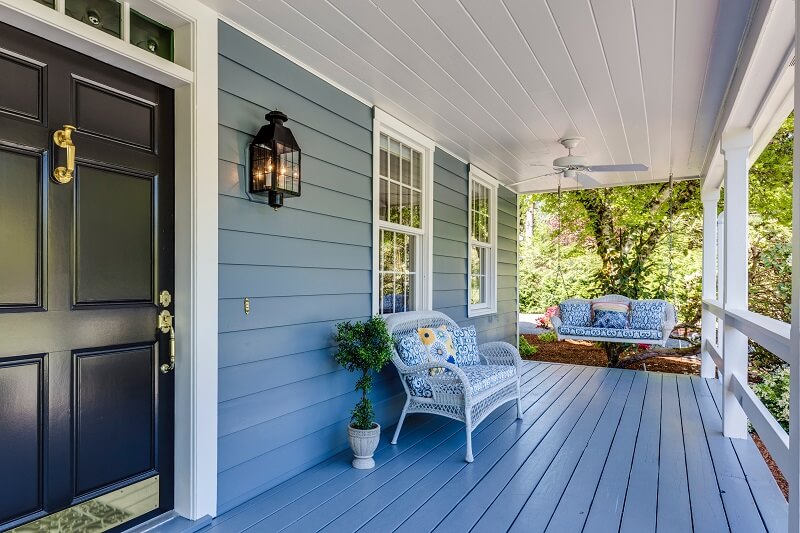
Since your outdoor furniture is going to be subjected to mush harsher conditions than your indoor furniture, it’s worth paying for quality materials and builds. You don’t save much money on a $25 chair if you need to buy a new one every summer.
The best materials for outdoor furniture are things like metal, resin wicker, or certain kinds of wood.
Metal furniture comes in many shapes and sizes:
Aluminum
Aluminum furniture is lightweight and needs minimal maintenance. Plus, it doesn’t rust and it’s easy to clean. Aluminum furniture also stands up to the elements better than most and is available in many styles.
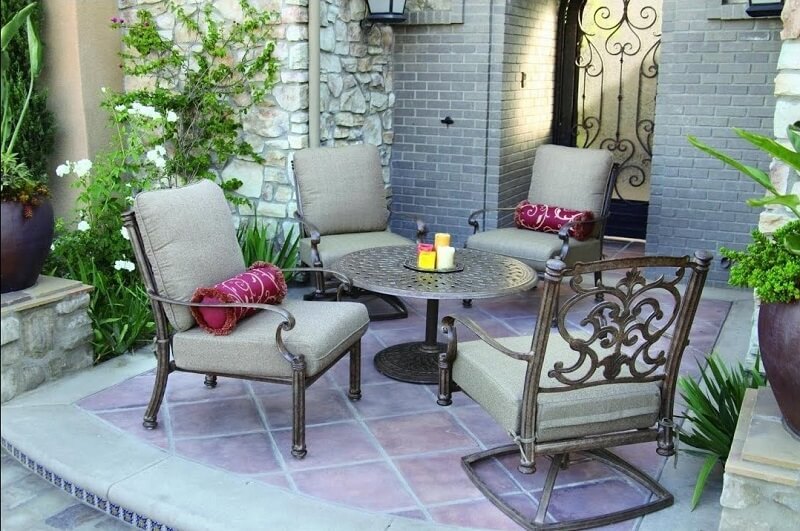
Wrought iron
Wrought iron furniture is heavy. That may be a good thing if your outdoor space is subject to heavy wind, though! Unlike aluminum, wrought iron is prone to rusting, so it needs to be covered or taken inside during wet weather. You can easily manage Rust by sanding and re-sealing the rusty spot with paint as soon as it’s visible.

Steel
Steel furniture is sort of a middle ground. Though expensive, it is resistant to the elements and lighter than iron. Steel furniture lends your space a modern, sophisticated look.
Resin wicker
(a.k.a. all-weather wicker) is a popular choice as well. Often, wicker furniture has a metal frame that’s covered by the signature woven material we call wicker. That weave is typically plastic, so resin wicker furniture stands up to the elements as well as anything. It comes in many different styles, too.
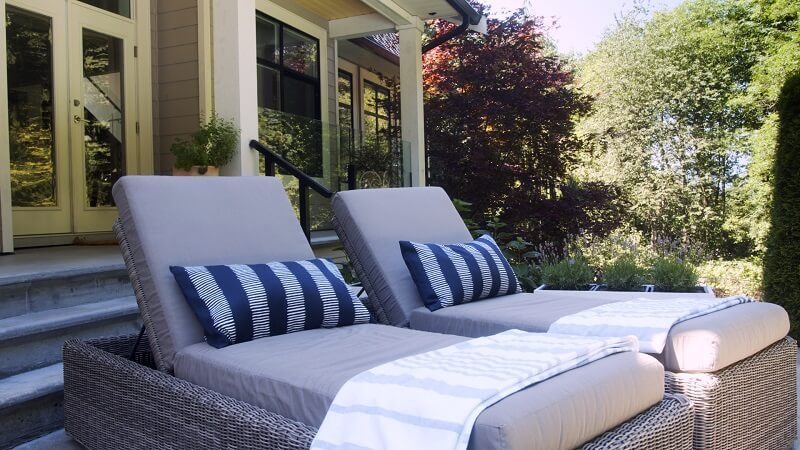
Plastic
There’s also the humble solid plastic furniture. Plastic furniture is inexpensive, and unfortunately often looks that way. You can’t beat its durability, though. Plastic furniture is often made of high-density polyethylene (HDPE), which is hard but lightweight.
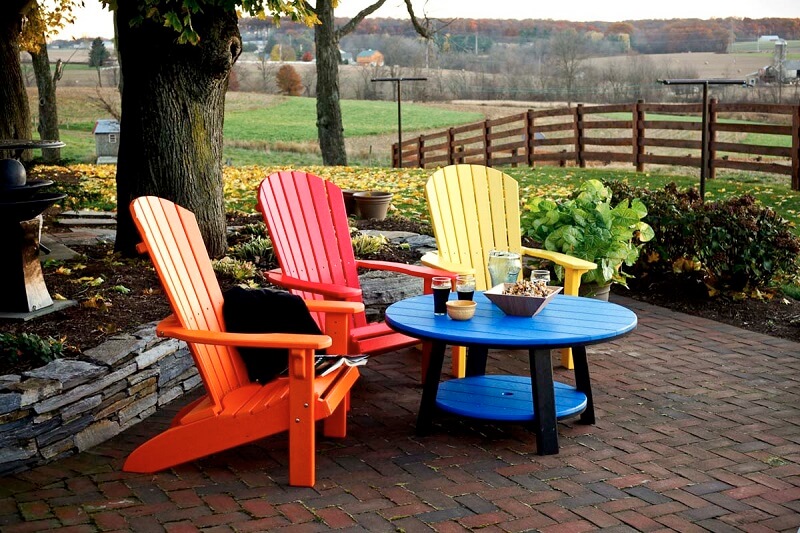
Wood
Finally, some types of wood furniture are well-suited to outdoor use. Wood furniture looks great and suits many design styles, but not all woods are created equal. Cedar, redwood, and teak are some of the best woods for outdoor furniture, thanks to their moisture-resistant resins and relatively light weight. Wood furniture doesn’t necessarily come cheap, though, and does require some upkeep in the form of occasional sanding or re-finishing.
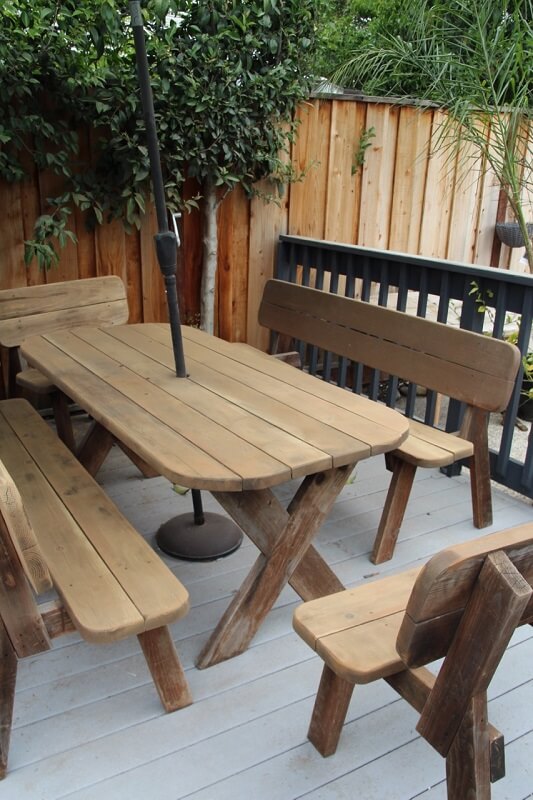
If you’re going to use your outdoor living space for cooking, do some research into the best options for designing an outdoor kitchen that suits your style.
Choose cushions and other fabrics
When it comes to cushions, make sure to find dedicated outdoor cushions (unless your patio is well-sheltered from the elements).
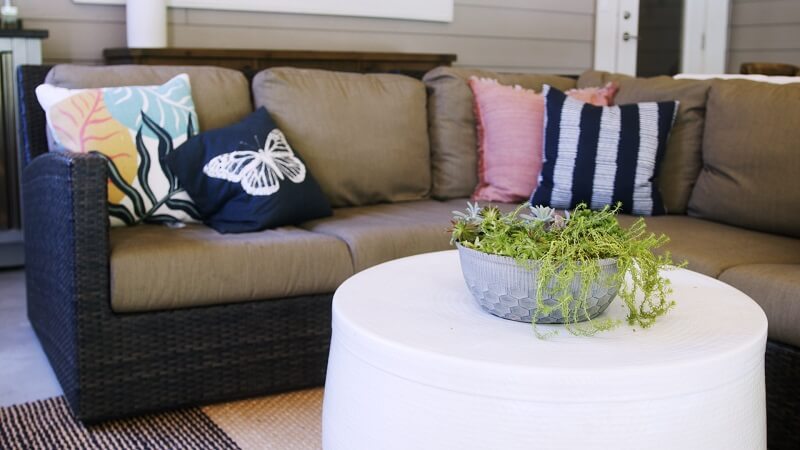
Outdoor cushion forms (like reticulated foam) are designed to dry quickly if they get wet. If you do have a sheltered outdoor space, you might be able to get away with softer, indoor cushions, but be ready to take them inside during inclement weather. Cushions that spend too much time being wet can develop mould and mildew.
When you’re choosing cushions and other fabrics, make sure you’re not setting yourself up for too much work. If you have to move a bunch of cushions from the house to the patio every time you want to use it, is that going to make you not want to use it at all? That’s why outdoor-rated cushions are best.
Fortunately, outdoor-friendly cushion covers and other fabrics come in as many colours and styles as you need to match your décor scheme. Focus on finding products that are UV-resistant and quick-drying. Regular fabrics fade quickly when exposed to direct sunlight, and they can take forever to dry if they get wet.
Speaking of textiles, you can use outdoor rugs to ground furniture within the space, or to create different zones within a very large outdoor space. For example, you might use a rug to visually set your sitting area apart from your cooking area, even if they’re right next to each other.
Note how the space is oriented
Unless you’re building a new home, chances are the location of your patio or balcony is set. That means it’s important to consider the space’s orientation relative to the house, the sun, and other natural elements.
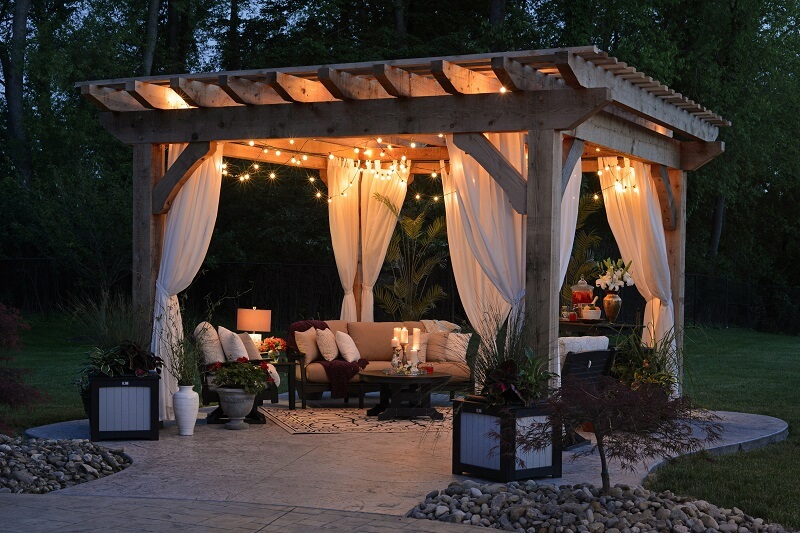
Is the space covered? Does it get direct sunlight in the morning, or afternoon? Is there a big tree that casts a shadow across the space at certain times of day?
Answers to these questions might affect your plans.
If you’ve decided to use your patio for dining, for example, you want to avoid subjecting your dining table to sweltering, late-afternoon summer sun. You may decide that you need to buy a shade sail or a patio umbrella.

If the wind usually comes from the same direction, you can plan to include wind buffers (like hedges) along one side of your patio.
A covered outdoor space gives you more flexibility than a wide-open one. If your outdoor space has a roof and a wall or two, you might be able to get away with indoor-only furniture or even large electronics like a television.
The orientation of your space will also affect what sorts of accessories you might add to it.
Accessorize your outdoor living space
The right accessories can take your outdoor space from good to great.
One big consideration is heat and light sources. Adding these can allow you to use your patio or balcony later into the night (or the year).
A fire source is never a bad choice, whether it’s in the form of a firepit or a gas-powered fire table. If you choose to install such a fixture, check that your local building codes and bylaws permit it, and make sure you’ve got a fire extinguisher handy nearby. Your home insurance provider might want to know about fireplaces as well.
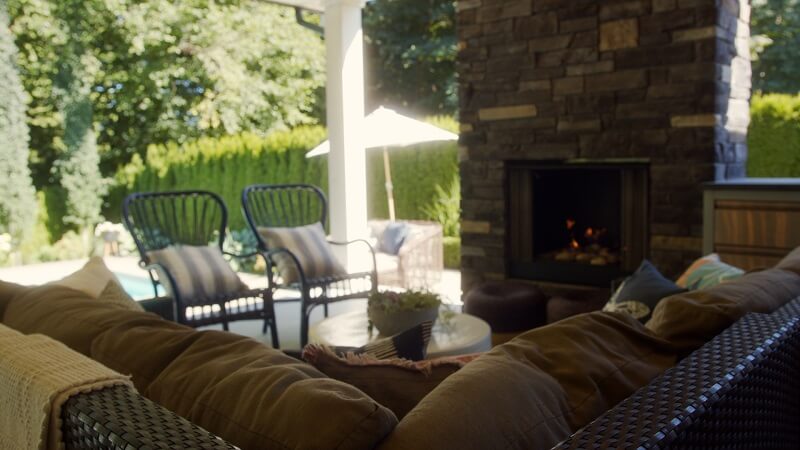
A full-size firepit might throw enough heat to keep you warm, but fire tables often don’t. If your chosen fire source isn’t enough to make your outdoor space comfortable during cool nights, you can also add some overhead heat lamps.
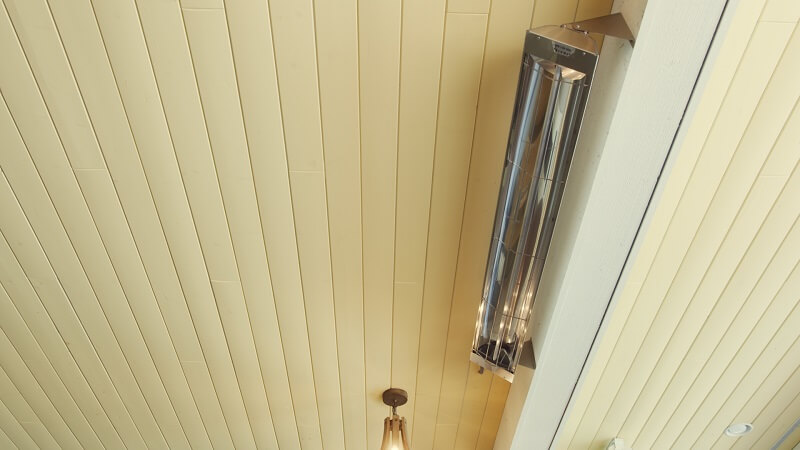
While they may not offer much heat or light, candles are a great addition to outdoor spaces if you’re planning on hanging out after dark.
If you’ve got mosquito issues in your part of the world, you can opt for mosquito-repellent citronella candles to keep the bugs at bay.
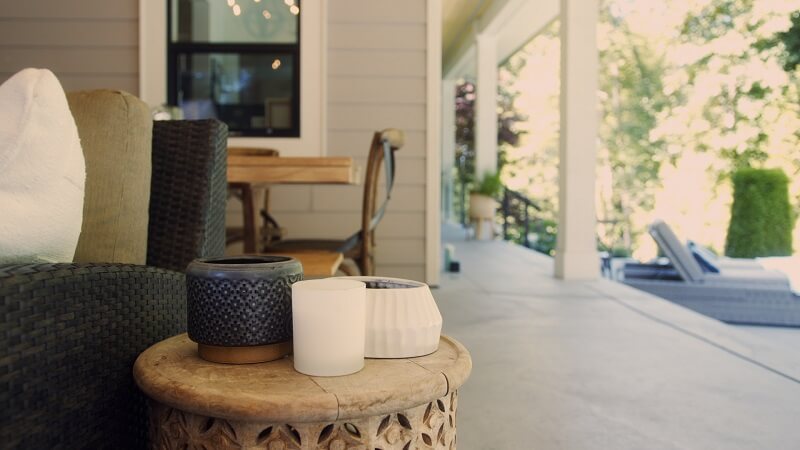
Whichever candles you choose, make sure you’re not keeping them in direct sunlight during the day — you may find only wax pools left when you go to use them.
Finally, adding some plant life to your patio or deck is a nice touch. A few plants on the patio create a transition zone between your house and the great outdoors. Large plants can even provide extra shade on top of their visual appeal.
Outdoor living spaces and home insurance
Most aspects of an outdoor space don’t have many special insurance considerations; furniture and other movable stuff are all part of your personal property (or contents) coverage.
Make sure your personal property coverage limit is high enough to cover your outdoor décor, especially if you’re buying a lot of new stuff.
Even though it’s part of the same category as your indoor furniture, outdoor furniture does face some extra risk as it’s exposed to the elements — and potential thieves.
While your home insurance policy may cover damage to your outdoor furniture from hailstorms or windstorms, it’s better to avoid the damage entirely. Keep your furniture stored away during inclement weather if you can.
Being outdoors, your patio furniture could be a target for thieves as well. If you’re going to be away from home for a while, store your outdoor furniture indoors if you’ve got the space — even if you’re just stacking it in the kitchen for a few weeks.
If your outdoor design project involves much construction or renovation, you might need to inform your insurance provider or purchase additional coverage. For example, if you’ve built a new patio or balcony, it could add a substantial amount to the rebuild value of your home. The coverage you need may be different depending on if the new structure is attached to your house or not, too. If you’re unclear on the right coverage, you can always ask your home insurance provider for guidance.
If you’ve done any landscaping, make sure your home insurance policy has the right coverage for that as well. Home insurance policies often include some coverage for things like trees and shrubs, but if you’ve added a lot, you’ll want to make sure that your coverage is still sufficient.
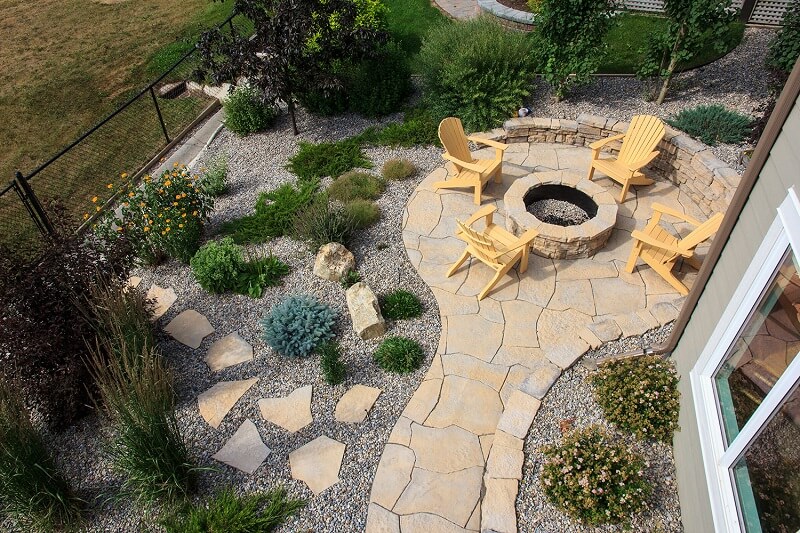
Square One offers coverage for detached structures, fences and landscaping all together as an optional coverage you can add to your policy if you need it.
Another consideration for outdoor living spaces is liability. If your outdoor setup leads to a visitor getting injured, you could be liable for those injuries. Make sure things like power cables or gas hoses aren’t tripping hazards, and generally keep the area safe for visitors.
Furniture and other components of your outdoor living space may suffer damage over time as they get baked by the sun or repeatedly wet by rain. Home insurance doesn’t cover wear and tear, so make sure you’re taking proper care of your outdoor space and the stuff in it.
Watch the full video
Want to learn more? Visit our Interior Design resource centre for inspiration and tips to help you create the perfect living space. Or, get an online quote in under 5 minutes and find out how affordable personalized home insurance can be.



